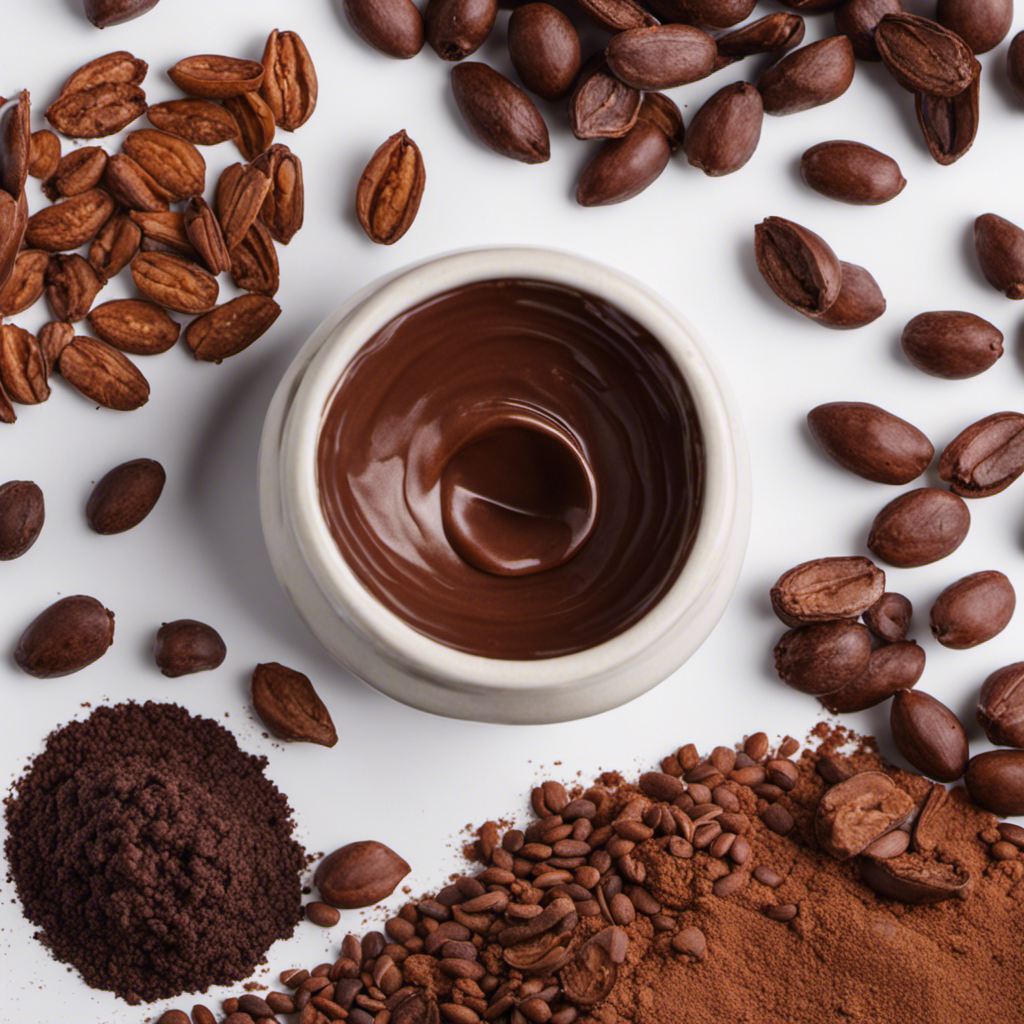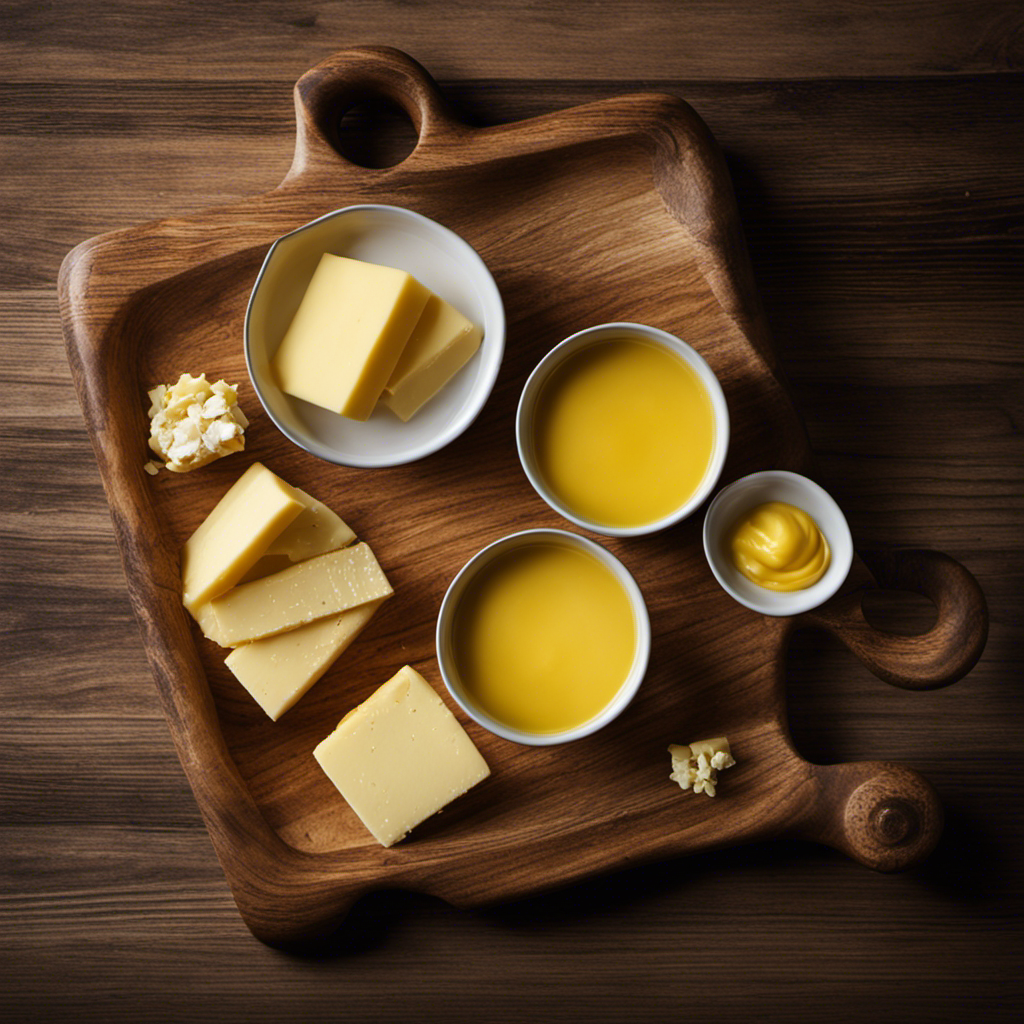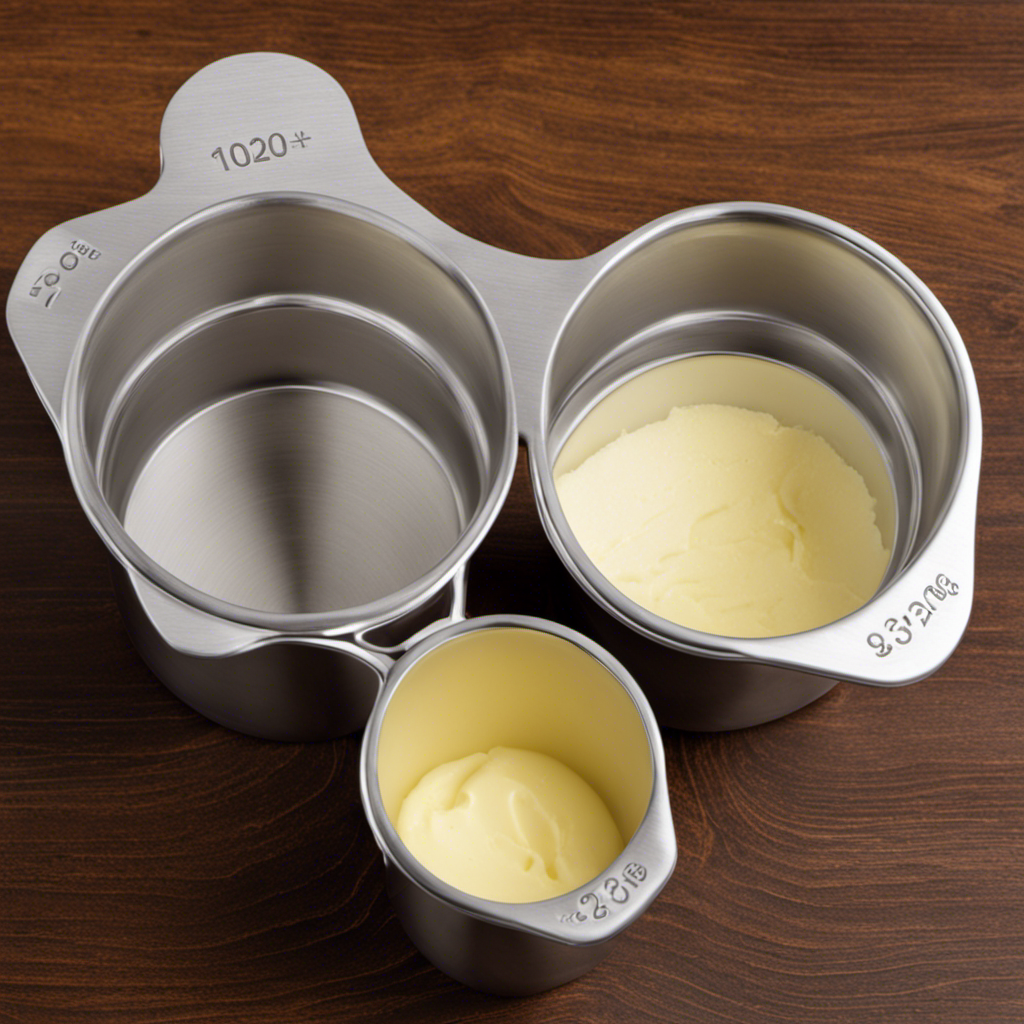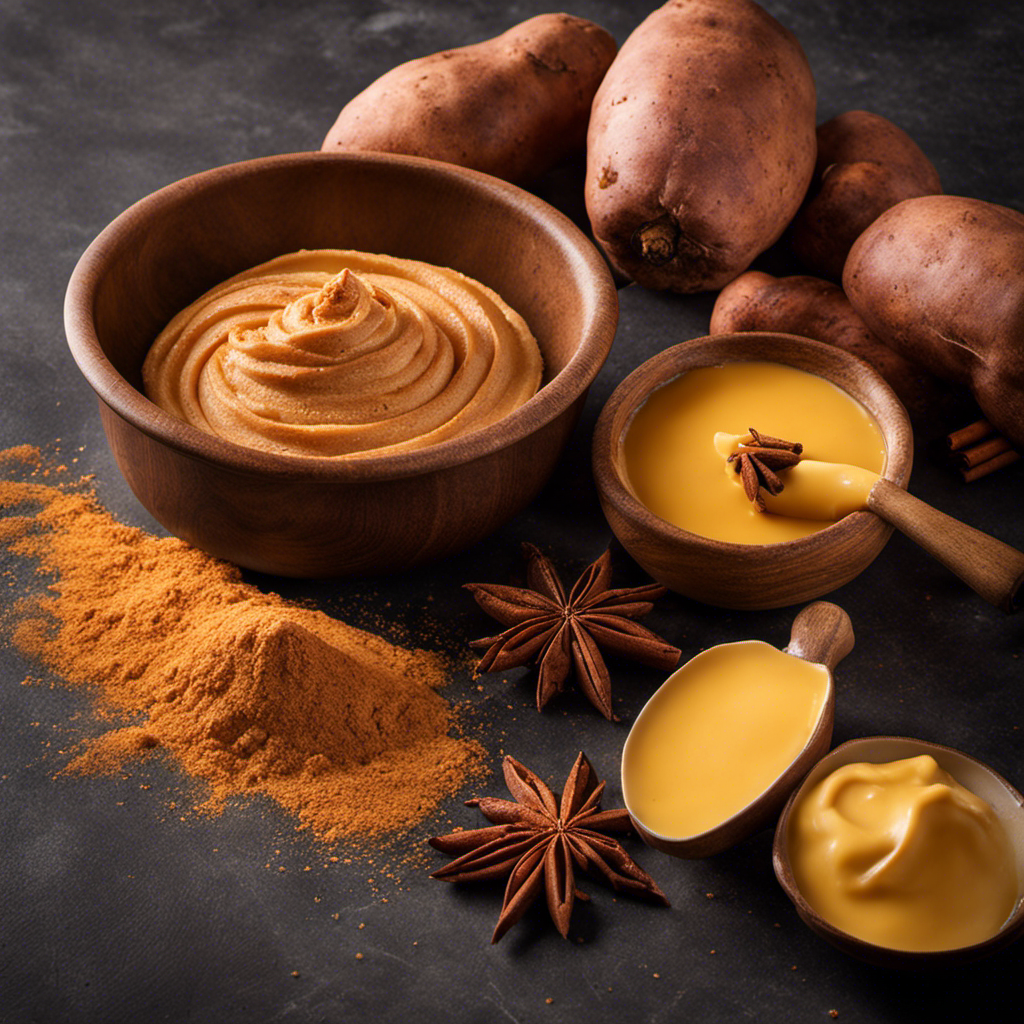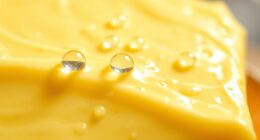I’ve consistently been captivated by the luxurious and smooth consistency of cacao butter. It feels like a gentle caress on your palate, infusing a lavish flair into every dish.
In this guide, I’ll show you how to make your very own cacao butter from scratch. From selecting and preparing the cacao beans to melting and straining the butter, I’ll walk you through each step with precision and clarity.
Get ready to embark on a delicious journey into the world of homemade cacao butter!
Key Takeaways
- Properly selecting and preparing cacao beans is crucial for high-quality butter production.
- Roasting unlocks the full potential of cacao beans for high-quality butter.
- Efficient separation techniques are crucial for high-quality butter.
- Filtering extracted cacao butter removes impurities for smoother texture.
Selecting and Preparing Cacao Beans
Before you start making cacao butter, you’ll need to select and prepare the cacao beans.
The first step is to choose high-quality beans that are fully ripe and free from any defects.
Once you have selected the beans, the next step is to prepare them through a process called dry fermentation. This involves placing the beans in a container and allowing them to ferment for several days.
During this time, the beans undergo chemical changes that enhance their flavor and aroma.
After fermentation, the beans are spread out in the sun to dry. Sun drying helps to remove excess moisture and further develop the rich flavors of the beans.
Once the beans are fully dried, they are ready to be processed into cacao butter.
Roasting and Grinding the Cacao Beans
Once you’ve roasted and ground the cacao beans, it’s time to move on to the next step in the process. Roasting techniques play a crucial role in developing the flavor profiles of cacao beans.
The roasting process brings out the complex flavors and aromas hidden within the beans. Different roasting times and temperatures can result in distinct flavor profiles, ranging from fruity and floral to nutty and earthy.
As a chocolatier, I experiment with various roasting techniques to achieve the desired flavor notes in my cacao butter. By carefully monitoring the temperature and duration of roasting, I can enhance the natural flavors of the beans and create a unique taste experience.
The roasting step is essential in unlocking the full potential of the cacao beans and ensuring the highest quality cacao butter.
Separating the Cacao Nibs From the Cacao Butter
When it comes to separating the cacao nibs from the cacao butter, efficient separation techniques are key.
This process is crucial in ensuring a high-quality butter extract.
Efficient Separation Techniques
To efficiently separate the cacao butter from the cacao nibs, you can use a technique called pressing. Here are four steps to maximize cacao butter yield:
-
Grinding: First, the cacao nibs are ground into a fine powder using a grinder. This step increases the surface area of the nibs, making it easier for the butter to be extracted.
-
Heating: The ground cacao powder is then heated to a specific temperature. This helps to melt the cacao butter, making it easier to separate from the solids.
-
Pressing: The heated cacao powder is placed in a hydraulic press. Pressure is applied, forcing the cacao butter to separate from the solids. The butter is collected, while the remaining solids, known as cacao cake, are discarded.
-
Filtering: Lastly, the collected cacao butter is filtered to remove any impurities, ensuring a pure and high-quality final product.
Quality of Extracted Butter
To ensure a high-quality final product, you should filter the extracted cacao butter to remove any impurities. This step is crucial in achieving the desired texture and consistency of the butter.
By removing impurities such as debris or any remaining cocoa solids, you can create a smoother and more refined butter. Additionally, filtering helps to prolong the shelf life of the butter and ensures its freshness over time.
It is recommended to use a fine mesh strainer or cheesecloth for this process to effectively remove any unwanted particles. Once filtered, store the cacao butter in an airtight container in a cool and dark place to maintain its quality.
Proper storage will help preserve the butter’s flavor and prevent it from becoming rancid.
Melting the Cacao Butter
When it comes to melting cacao butter, there are two key points to consider: the ideal melting temperature and the time required for melting.
The ideal melting temperature for cacao butter is around 104-113°F (40-45°C), as this ensures a smooth and consistent melt without compromising the quality of the butter.
The time required for melting can vary based on the quantity of cacao butter being melted, but generally it takes around 15-20 minutes for the butter to fully melt.
Ideal Melting Temperature
The ideal melting temperature for cacao butter is around 90 to 95 degrees Fahrenheit. To achieve this temperature, various melting methods can be employed, depending on the equipment available. Here are four common methods used for melting cacao butter:
-
Double Boiler Method: This involves placing the cacao butter in a heatproof bowl, which is then set over a pot of simmering water. The indirect heat gently melts the butter without scorching it.
-
Microwave Method: Cacao butter can be melted in a microwave-safe bowl by heating it in short intervals and stirring in between. This method requires careful monitoring to prevent overheating.
-
Sous Vide Method: By placing the cacao butter in a vacuum-sealed bag and submerging it in a water bath set at the desired temperature, precise control over the melting process can be achieved.
-
Melting Pot Method: Using a specialized melting pot or chocolate melter, the cacao butter can be melted gradually and evenly, ensuring a smooth consistency.
Now that we know the ideal melting temperature and the various methods and equipment needed, let’s explore the next step: the time required for melting.
Time Required for Melting
You can determine the time required for melting by considering the method and equipment you are using. The melting time of cacao butter can vary depending on various factors such as the temperature, the size and shape of the cacao butter pieces, and the melting technique employed.
If you are using a direct heat method, such as a double boiler, it may take around 10-15 minutes for the cacao butter to melt completely. On the other hand, if you are using an indirect heat method, like a sous vide machine, it may take longer, approximately 20-30 minutes.
It is important to note that the melting time can also be influenced by the quality of the cacao butter and the consistency of the heat source. Therefore, it is crucial to closely monitor the melting process to ensure a smooth and consistent result.
Straining and Filtering the Cacao Butter
To strain and filter the cacao butter, start by placing a fine mesh strainer over a clean bowl. This will help remove any impurities and ensure a smooth texture.
Here are some straining techniques and alternative filtering methods you can use:
-
Cheesecloth: Line the strainer with cheesecloth to catch any small particles or solids present in the cacao butter.
-
Coffee filter: For a finer filtration, you can use a coffee filter instead of a mesh strainer. This will give you a smoother and more refined cacao butter.
-
Chinois: A chinois is a cone-shaped strainer with a very fine mesh. It is often used in professional kitchens for straining sauces and liquids. It can also be used to strain cacao butter for a high-quality result.
-
Nut milk bag: Similar to a cheesecloth, a nut milk bag is a fine mesh bag that can be used to strain the cacao butter. It is especially useful for removing any remaining solids or sediment.
Once you have strained and filtered the cacao butter, you can move on to the next step of storing and using the homemade cacao butter.
Storing and Using the Homemade Cacao Butter
Once strained and filtered, I store my homemade cacao butter in an airtight container. It’s crucial to keep it in a cool, dry place to maintain its freshness and flavor. Storing cacao butter correctly ensures that it remains in perfect condition for a long time.
Besides using cacao butter in skincare, it can also be incorporated into various recipes. When used in skincare, cacao butter provides deep hydration and nourishment to the skin, leaving it soft and supple. It can be used in homemade body butters, lip balms, and moisturizers.
In recipes, cacao butter adds a rich and creamy texture to dishes like chocolate desserts, smoothies, and even savory sauces. Experimenting with cacao butter in both skincare and cooking can unlock a world of delicious and skin-loving possibilities.
Frequently Asked Questions
How Long Does It Take to Make Cacao Butter From Start to Finish?
It takes a considerable amount of time to make cacao butter from start to finish. The cacao butter making process involves several steps that require patience and attention to detail.
Can I Use Any Type of Cacao Beans to Make Cacao Butter?
Yes, you can use different types of cacao beans to make cacao butter. The extraction process remains the same regardless of the variety. However, the flavor profile may vary depending on the beans used.
Are There Any Health Benefits to Using Homemade Cacao Butter Compared to Store-Bought Options?
There are potential health benefits to using homemade cacao butter compared to store-bought options. Homemade cacao butter allows for control over the ingredients and process, potentially resulting in a higher quality product.
Can I Add Any Additional Flavors or Ingredients to the Cacao Butter?
Yes, you can enhance the flavor of cacao butter by adding various ingredients. Flavor variations can be achieved by incorporating spices, such as cinnamon or vanilla, or by using alternative ingredients like coconut oil or almond extract.
How Do I Know if the Cacao Butter Has Gone Bad and Is No Longer Safe to Use?
When it comes to cacao butter, it’s important to know if it’s gone bad. Signs of spoiled cacao butter include a rancid smell and taste, as well as a change in texture. Its shelf life is generally around 2-5 years.
Conclusion
In conclusion, making cacao butter at home is a meticulous process that requires patience and attention to detail. From selecting and preparing the cacao beans to melting and straining the butter, every step plays a crucial role in achieving the desired end result.
By following these steps, you can create your own homemade cacao butter, a versatile ingredient that can be used in various culinary creations.
So, why wait? Start experimenting with cacao beans and unlock a world of rich, velvety flavors that will leave your taste buds craving for more.
